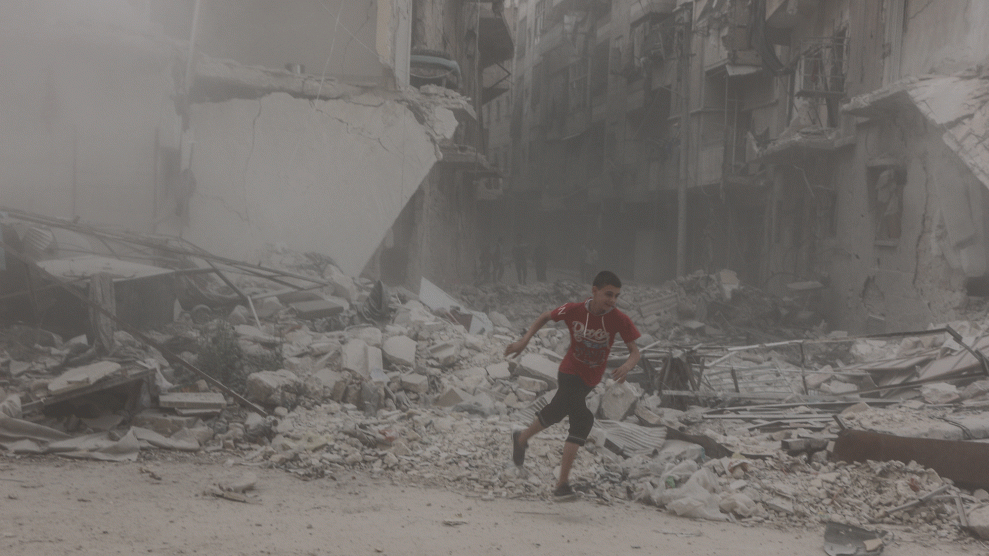
A boy runs in Aleppo, Syria, following airstrikes on October 2. Basem Ayoubi/ImagesLive via ZUMA Wire
Since the collapse of the United States-Russia brokered cease-fire in Syria, the Assad regime and its Russian allies have been hammering rebel-held areas of Aleppo, where 275,000 residents—including 100,000 children—are trapped. Amid the worst bombardment the city has experienced since the beginning of the civil war, activists are reporting many as 250 airstrikes in a single day. Hundreds have died, including at least 100 children. “This is the worst bombing we’ve seen,” one resident told The Economist last week. “The new weapons make the ground beneath our feet shake. It feels like the end of the world.”
The new weapons he was referring to include a variety of high explosive bombs, incendiary munitions, “bunker buster” bombs, and thermobaric-type munitions. Russia’s support for the Assad regime includes the deployment of sophisticated weaponry that’s far more destructive than the government’s brutal tactic of dropping barrel bombs on civilian targets. Since the Russians joined the bombing campaign last year, they’ve wiped out 10,000 Syrians, including at least 4,000 civilians. Before its scorched-earth blitz on Aleppo, Russia passed a sobering milestone in August, when it beat out ISIS for the number of civilians it had killed.
Here’s a look at a few of the Russian-made weapons reportedly being used against civilians in Aleppo.
TOS-1A: On September 25, Russia was accused of using a TOS-1A in Aleppo, a surface-to-surface rocket system that fires thermobaric-type warheads. TOS stands for “heavy flame thrower,” but it fires a rocket carrying a “fuel-air explosive” (FAE). One Western diplomat has described it as “one step down from a nuclear weapon,” which is an overstatement but speaks to its power. N.R. Jenzen-Jones, a weapons expert and the director of Armament Research Services, explains that the weapon’s enormous blast waves cause most of the damage: “FAE devices generally consist of two separate explosive charges and a fuel container, with their initial charge designed to function at a predetermined height, dispersing a cloud of fuel from the container. Certain hydrocarbons and their oxides form detonable aerosols, and this fuel cloud, mixing with atmospheric oxygen, can surround and penetrate objects and structures. The second charge detonates this cloud, causing a massive blast wave that damages or destroys structures, equipment, and personnel.”
Footage of TOS-1A impacts, incendiary cluster munitions, TOS-1A launches, combat around the military colleges,Aleppo pic.twitter.com/z86BErYDOy
— BM-27 Uragan (@bm27_uragan) September 5, 2016
BETAB-500: This is the main bomb Russia is using to flatten eastern Aleppo. Designed to pierce through reinforced concrete and penetrate deep underground before exploding, BETAB-500s can take entire buildings down. They are “typically used to engage hardened targets, such as munitions storage sites, bunkers, subsurface targets, or hardened aircraft shelters,” says Jenzen-Jones. Russia has allegedly used them since it joined Assad’s air campaign to destroy ISIS’ underground bunkers and weapons caches. But this is believed to the first time they’ve been deployed in an urban environment full of civilians.
This is what Vladimir Putin is using to destroy underground hospitals & schools in #Aleppo. pic.twitter.com/A2ow91xacg
— Kenan ???? (@KenanRahmani) October 4, 2016
ShOAB 0.5 cluster munitions: A video obtained by NBC News shows apparent evidence that Russian-made ShOAB 0.5 cluster munitions were used to attack at least one hospital in Aleppo. Cluster munitions, which are known for causing indiscriminate carnage, spread out over wide areas and explode in mid-air. The bomblets (also known as submunitions) that fail to detonate can become de facto landmines, later maiming civilians who find them on the ground. “Some fifteen different types of submunitions are known to have been employed in Syria, more than in any other recent conflict,” notes Jenzen-Jones.
@MacWBishop @johnismay @NBCNews
Probable Russian ShOAB 0.5 cluster bomb submunitions VIC Aleppo hospital #UXO pic.twitter.com/vuTvVLrlSx
— Michael Adams (@mla1396) September 30, 2016
These three weapons are a sampling of what’s being used in Syria. “The range of different types and models employed is far more diverse than many observers realize, and contains significantly more variety than recent air campaigns waged by NATO member states,” says Jenzen-Jones. He adds that unexploded weapons could make the eventual cleanup of battlefields like Aleppo into a nightmare.
On Monday, the United States formally suspended talks with Russia on Syria because of its role in the assault on eastern Aleppo, and also postponed its plans for joint military targeting of jihadist groups like ISIS. On Wednesday morning, the Assad regime made a surprise announcement that it is easing its bombardment of Aleppo so civilians may leave, only to add later that anybody who remains after being offered the opportunity to leave will face their “inevitable fate.”





